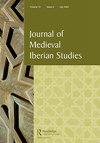The late medieval/early modern necropolis of Adro Vello (O Grove, Pontevedra, Spain) from sondage 1.2017: an osteoarchaeological approach to funerary practices and childhood
IF 0.4
2区 历史学
0 MEDIEVAL & RENAISSANCE STUDIES
引用次数: 0
Abstract
ABSTRACT The study of non-adult individuals and the concept of childhood are essential for deepening our knowledge of past communities. Adro Vello (O Grove, Pontevedra) is considered one of the most representative and iconic necropolises of medieval Galicia. However, research on the human skeletal remains has so far been scarce and has not previously focused on what osteoarchaeological analyses can reveal about lifestyle. Here we study the human skeletal remains recovered in a 2017 archaeological campaign. The results show a Minimum Number of Individuals (MNI) of fourteen – seven articulated individuals, and MNI of seven among disarticulated skeletal remains – eight of whom are non-adults (including six individuals ≤ one year). The analysis in this article revolves around the management of cemetery space, the relationship of burials with earlier and later structures, and, especially, the high presence of individuals under the age of one year in a Christian cemetery, where burial of the unbaptised would not be allowed. This demonstrates the importance of archaeological and bioarchaeological study in detecting ex norma practices and in the characterisation of childhood.Adro Vello (O Grove, Pontevedra, Spain)的中世纪晚期/现代早期墓地:对丧葬习俗和童年的骨考古方法
摘要对非成年个体和儿童概念的研究对于加深我们对过去社区的了解至关重要。Adro Vello(O Grove,Pontevedra)被认为是中世纪加利西亚最具代表性和标志性的墓地之一。然而,到目前为止,对人类骨骼遗骸的研究很少,以前也没有关注骨考古分析能揭示生活方式。在这里,我们研究了2017年考古活动中发现的人类骨骼遗骸。结果显示,最小个体数(MNI)为14-7个有关节个体,无关节骨骼遗骸中的最小个体数为7个,其中8个为非成年人(包括6个个体 ≤ 一年)。这篇文章中的分析围绕着墓地空间的管理,埋葬与早期和后期结构的关系,特别是基督教墓地中一岁以下的人非常多,在那里不允许埋葬未接种疫苗的人。这表明了考古和生物考古研究在发现非规范做法和儿童特征方面的重要性。
本文章由计算机程序翻译,如有差异,请以英文原文为准。
求助全文
约1分钟内获得全文
求助全文
来源期刊

Journal of Medieval Iberian Studies
MEDIEVAL & RENAISSANCE STUDIES-
CiteScore
1.20
自引率
20.00%
发文量
24
 求助内容:
求助内容: 应助结果提醒方式:
应助结果提醒方式:


